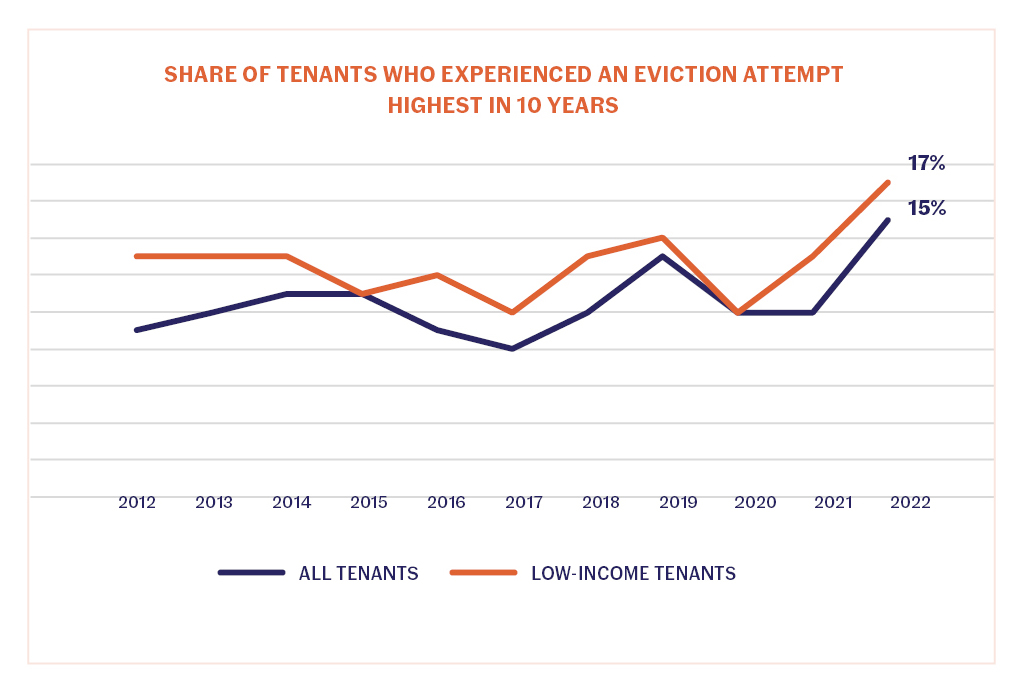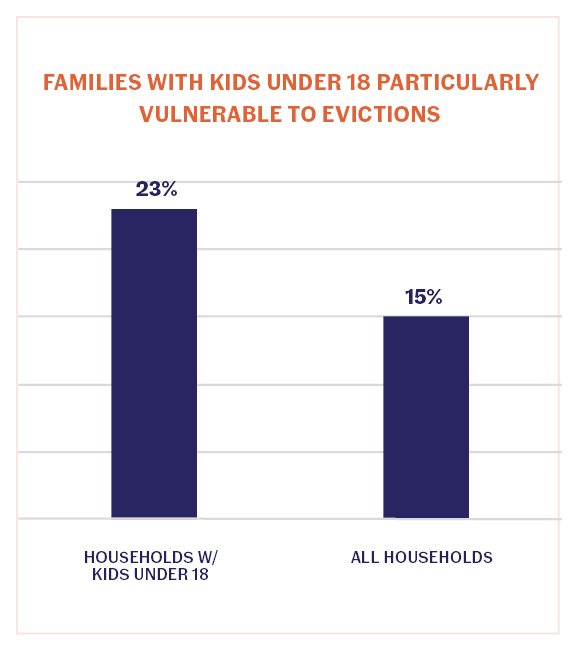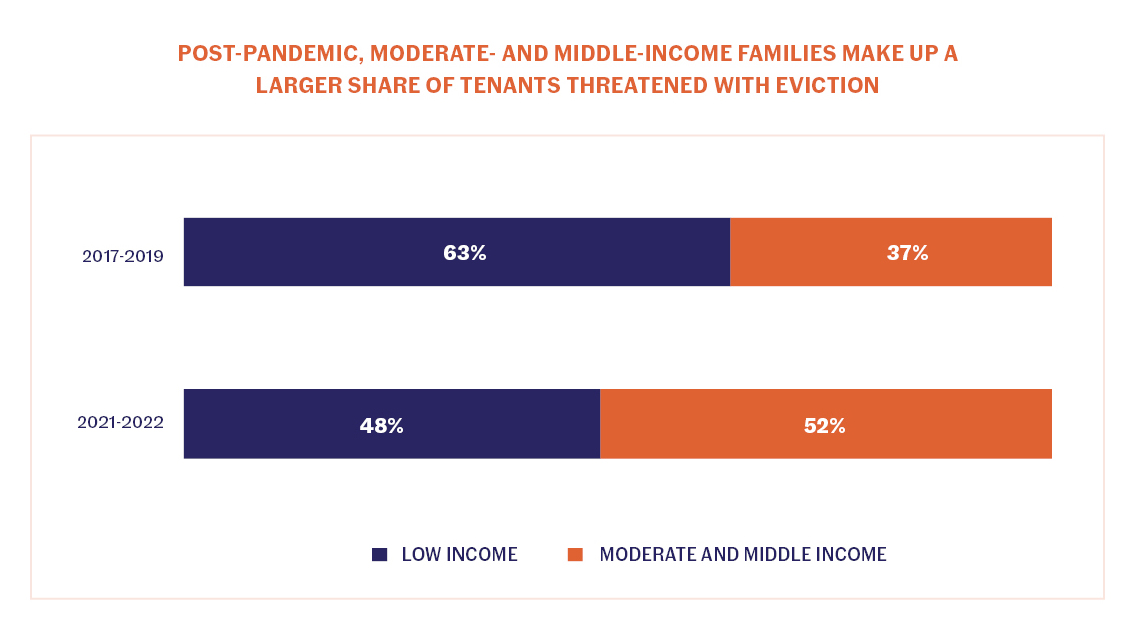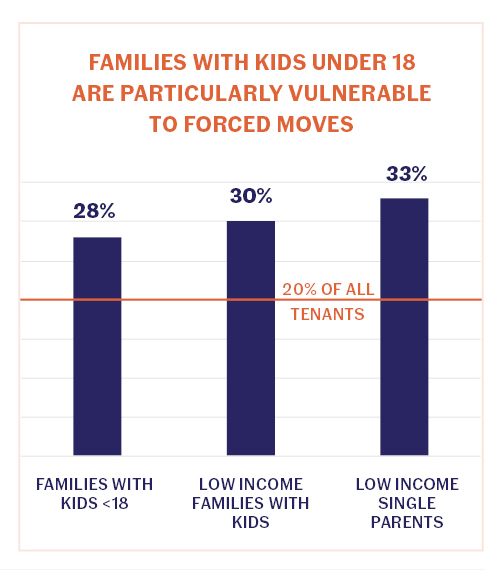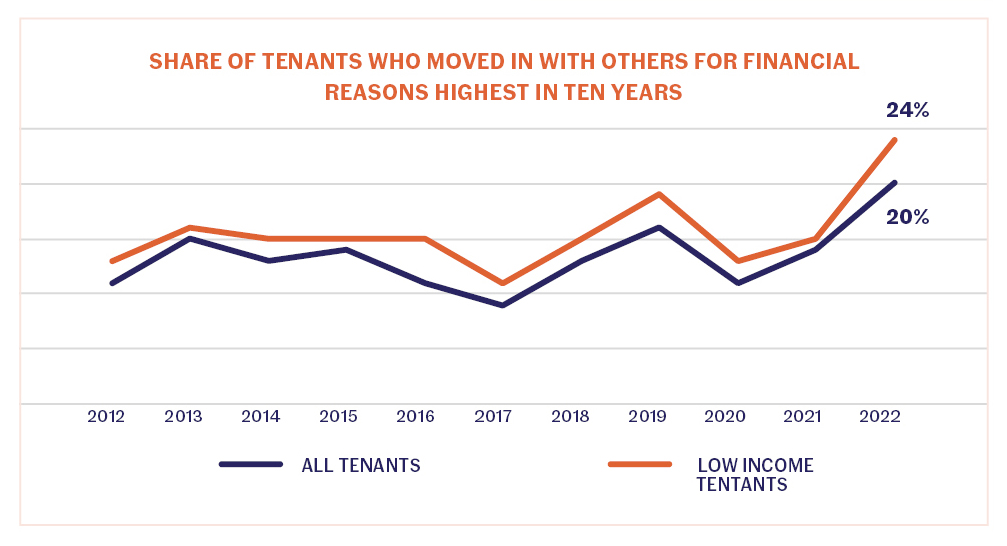Assembly-Line “Justice”: Eviction Attempts Reach Record Highs in 2022
Oksana MironovaSamuel Stein
Context
From 2020 to 2021, New York held off a sharp increase in evictions with rental assistance programs and an eviction moratorium. With the end of the moratorium in early 2022, eviction filings climbed sharply. It is not as if no one saw it coming. Jenny Laurie, Executive Director of Housing Court Answers, cautioned against the return to a “pre-pandemic assembly-line style of justice in Housing Court”.[1] Instead of heeding this warning, the NYS Unified Court System made the choice to speed up the assembly line in 2022. At the same time, the city failed to respond to growing resignations among legal service lawyers, and the state legislature failed to adopt a statewide Right to Counsel law. As a result, tens of thousands of tenants are now facing evictions without legal support they are legally entitled to.
Summary of Recommendations
- New York’s court system should only move forward with eviction cases where eligible tenants have legal representation.
- The state legislature should pass the Statewide Right to Counsel and Winter Eviction Moratorium bills.
- The State should adequately fund full Right to Counsel implementation.
Key Findings
- In 2022, 15 percent of all tenants were targeted for eviction, the highest share in a decade.
- Twenty three percent of families with kids under 18 faced evictions in 2022. Families with children under 18 account for nearly half of attempted evictions, while making up only 28 percent of New York City’s households.
- More than half (52 percent) of tenants threatened with evictions were moderate- to middle-income in 2021-2022, a 15-point post-pandemic increase; 80 percent of these respondents were either employed full time or had a partner who was.
- One in five tenants of all incomes – and nearly one in four low-income tenants – have had to move in with others because of financial reasons in 2022.
- Today, 225,000 New Yorkers are on the cusp of an eviction because they owe back rent, anticipate falling behind on their rent soon, and have less than $500 in savings.
Nearly 225,000 households are in immediate danger of eviction in New York City today
New York City will enter 2023 with over 260,000 eviction cases filed in its five housing courts. From the 2022 Unheard Third survey, we can extrapolate that an additional 225,000 New Yorkers are on the cusp of an eviction because they owe back rent, anticipate falling behind on their rent again in the next three months, and have less than $500 in savings.
Before the pandemic, the number of eviction filings in housing court decreased by 31 percent from a high point in 2013 to 171,539 in 2019.[2] This happened because of organized tenant pressure on the legislature to pass protenant legislation and devote more resources to eviction defense.
Another year of inaction by the courts and the legislature will roll back these gains, leading to more precarity, evictions, and homelessness in New York City.
Evictions, then and now
In late 2017, New York became the first city in the country to implement a Right to Counsel (RTC) law. RTC proved to be effective from the onset. Looking back at two years of data in late February 2020, we found that evictions in zip codes covered by RTC declined by 29 percent, 13 points more than in non-RTC zip codes with similar eviction, poverty, and rental rates. Further, 84 percent of tenants with access to counsel in eviction cases were able to stay in their homes.[3]
With the onset of the pandemic in March 2020, emergency measures like the eviction moratorium and emergency rental assistance temporarily held back eviction rates. But the expiration of these measures combined with a period of sharp rent inflation resulted in an explosive eviction crisis that is undermining pre-pandemic gains.[4]
When New York City’s RTC law was first implemented, the goal was to expand representation geographically, reaching full coverage by 2022. The pandemic sped up the law’s city-wide rollout by a year. Today, however, only 35 percent of eligible households facing eviction in housing court receive legal help, roughly equal to the share of tenants with counsel before the pandemic started in 2019.[5] Analysis by the publication The City last year showed that tenants living in upper Manhattan, the Bronx, and northeast Queens and the Rockaways had the least access to attorneys.
At the same time, it is important to note that before the implementation of Right to Counsel only one percent of tenants had an attorney, and housing court was known as an “eviction machine.”
As of today, there are over 260,000 eviction filings in New York City. About half of these filings are unresolved pre-pandemic cases, in which tenants had a temporary moment of reprieve, but likely find themselves in a worse situation economically than before the pandemic. At the same time, with increasing rents, depleted resources, and lack of support, nearly one in four tenants carry rent debt. As a result, as our latest Unheard Third survey shows, 15 percent of all tenants have been threatened with an eviction in 2022, the highest share in a decade.
Families with kids are most vulnerable to eviction
Our latest Unheard Third survey shows that families with children under 18 account for nearly half of attempted evictions, while making up only 28 percent of New York City’s households.[6[ Eleven percent of eviction attempts targeted single parents, who are overwhelmingly mothers (and make up only 6 percent of NYC households).
As illustrated in the chart, 23 percent of families with kids under 18 faced an eviction attempt in 2022, 8 points more than the average tenant.
Our findings fit in a larger context of worse economic outcomes for families with children. Student homelessness increased during the pandemic, according to research by Advocates for Children. According to a December 2022 report from the NYS Comptroller, poverty rates are much higher for children than for adults in New York State overall. The expiration of federal stimulus supports, like the expanded child tax credit, will undoubtedly further exacerbate poverty rates among children.
Moderate-income families face higher eviction risk post-pandemic
Our Unheard Third data shows a shifting picture of who is targeted with eviction attempts. Before the pandemic, 37 percent of respondents reporting experiencing eviction attempts were moderate or middle income. Today, 52 percent of respondents are.
Among the moderate- and middle-income respondents who have faced eviction in 2022, 80 percent were either employed full time or had a partner who was. These shifting income levels are likely a result of skyrocketing rent inflation and growing rent debt among moderate-income people. Given a growing need for eviction defense among moderate-income people, it is especially important to make the Right to Counsel law universal.
Forced moves are highest in ten years, impacting nearly one in four low-income tenants
With the eviction machine churning, the share of tenants forced to double up with others for financial reasons is the highest it’s been in ten years. One in five tenants of all incomes are doubling up – and nearly one in four low-income tenants are doing the same. For some, moving in with others represents a temporary disruption. But for many, it is a step toward ongoing housing insecurity and homelessness.
As with eviction attempts, families with kids under 18 are more likely to be forced to move in with other people than the average tenant household. Families with kids are 8 points more likely to move in with other people than the average tenant household.
One in three low-income single parents (33 percent) were forced to move in with others last year, 13 points more likely than the average tenant household.
The commonplace displacement of families with kids is especially a cause for concern given that one in ten New York City public school students were already homeless, two-thirds of whom were doubling up with another family.
Recommendations: Honor, Fund, and Expand the Right to Counsel and Strengthen Eviction Protections
Honor NYC’s Right to Counsel law: First and foremost, the New York State Court System must abide by NYC law and adjust its case calendaring schedule, moving forward only those eviction cases where qualified tenants have legal representation per NYC RTC law, as called on by advocates, legal service providers, and Borough Presidents Levine and Gibson (who championed the city’s RTC law when they were councilmembers). This would put the courts in compliance with the city law and put a highly successful anti-eviction strategy back on track.
Pass and fund Statewide Right to Counsel: The adoption of a statewide Right to Counsel law would both help curb evictions across the state and strengthen New York City’s RTC. The bill’s passage would expand coverage to moderate and middle income tenants in New York City and include cases not covered by New York City’s law, like tenant-initiated cases and appeals.
The adoption of RTC statewide must include a commitment to ongoing funding. The Right to Counsel Coalition has estimated that the state would need to appropriate $172 million in implementation funding, including $62.5 million for expansion of RTC in New York City.
Prohibit winter evictions: A winter eviction moratorium would ensure that no one goes homeless at a time when death from exposure is a real threat in many parts of New York State, as the tragic aftereffects of the recent winter storm in western New York shows. This law exists in several cold-weather countries around the world and was passed last year in Seattle.
About The Unheard Third Survey
The 2022 Unheard Third is a scientific telephone survey of 1,968 New York City adult residents reached by cell phones and landlines from July 12th through August 18th, 2022. It was designed by Community Service Society in collaboration with Lake Research Partners, who administered it using Random Digit Dialing and professional interviewers. The sample included 1,234 low-income residents (up to 200% of federal poverty standards, or FPL), and 734 moderate and higher-income residents (above 200% FPL). Interviews were conducted in English, Spanish, and Chinese. The margin of error for the entire survey is +/- 2.2 percent, for the low-income component is +/- 2.8 percent, and for the higher-income component is +/- 3.6 percent, all at the 95% confidence interval. For further information on the survey please reach out to Emerita Torres at etorres@cssny.org.
Notes
1. November 2021 Public Hearing on OCJ’s Universal Access to Legal Counsel Program Transcript.
2. CSS calculation based on eviction filings data published in the Office of Civil Justice’s Universal Access to Legal Services Reports 2018-2021.
3. Public Hearing on OCJ’s Universal Access to Legal Counsel Program Transcript.
4. To read more about rent increases in NYC in 2022, see Good Cause for Alarm: Rents Are Rising for Low-Income Tenants in Unregulated Apartments.
5. See NYC Office of Civil Justice’s Annual report for 2020.
6. US Census’ American Community Survey (ACS) 2021 5-year estimate.

